Vocabulary Among Dog Trainers: A Nearly Un-navigable Terrain
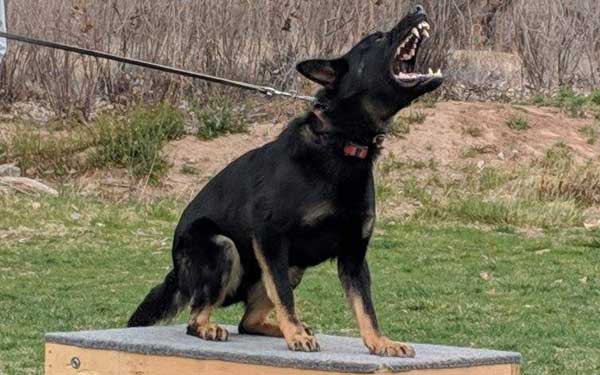
Foreword by Ed Frawley
I met Kevin Sheldahl in 1984 at a police K-9 school in Kansas. We have been good friends ever since. Kevin is a retired police K-9 handler. He became a K-9 Instructor and an International Police Dog Judge. Kevin's company K-9 Services runs 6-week police K-9 courses in which police officers learn how to become new K-9 handlers. To date, he has run 70 6-week courses and trained over 1,200 K-9 handlers. I don't know of another dog trainer that has Kevin's experience and knowledge of police service dogs training.
It is often that I travel and work with handlers in law enforcement and even in civilian training arenas. One thing is evident as I talk with working dog practitioners and enthusiasts. The vocabulary of working dog sports and industry is an eclectic mix of science, pseudo science, colloquialisms, jargon, and self-promotion by coining new terminology.
There have been attempts to try to standardize the vocabulary. These attempts have seen little success. The largest attempt in the US has been SWGDOG.
Prior to the SWGDOG attempt to define terminology in working dog training, there was a collaboration among Ethologists and the Police in Northrine-Westfalia at the School for Police Dog Handlers in Stukenbrock. Therein about 1950, scientists and police dog instructors set out to put together a curriculum for handlers attending the school. Over the years the program has changed as all programs do. But from this, the vocabulary used to describe and communicate about the behavior of police dogs has remained. It is a result of the science of ethology (the study of animal behaviors). To be more specific, we are talking about cynology (the study of the domestic dog). Vocabulary can be very useful in communicating about the desirable and undesirable traits and intrinsic behaviors we call drives and character traits for application in police dog training.
I hear people talk about drives frequently and some "do not believe in drive theory" which is like saying I don't believe it is intrinsic for me to breath. I also hear people talk about "ball drive" which also makes no sense. The intrinsic behavior is evolutionary and relates to natural behaviors, even if they have been altered by selective breeding and rearing practices. There have been no selective pressures for a dog to want to chase and possess a ball. But, a ball could represent an artificial prey item for which a dog's intrinsic behavior to chase prey and possess it has been associated and selected for!
One thing about ethology that the dog trainer must understand is that it has as its viewpoint how the organism interacts with its environment. In the case of cynology (that is the study of the domestic dog) and in the work we do in training dogs, it is the trial field or training field or in the case of the police dog or search and rescue dog, the operational environment. When one understands the context, the use of terminology including drives and character traits makes total sense to help us communicate dog behaviors. Communication among handlers and instructors for selection testing and training dogs for the work becomes more cohesive. Where it makes little sense is in the laboratory where we must quantify the behaviors being observed by a researcher. Here, the term 'drive' is of little use.
Among dog training enthusiasts, the naming of behaviors tends to be a selling point among trainers. Terms have been developed (with good intentions, I am sure) that have become associated with a popular trainers who coined a new phrase or defined a behavior in a certain way. Within the police dog community, vocabularies have sprung up from what I will call "camps". These may have arisen from various terms put into use among different generations of military handlers, regional training groups, and influential persons within these "camps" to include publications/books on canine training.
Of course, among dog enthusiasts, there is always the political angle as well. This comes from what group one aligns themselves whether sport or professional. They will adhere to the terminology that is used among that group and often defend it with vigor.
Another group that causes discourse in the community in regards to terminology is what I will call the pseudo-scientific folks. They want to assign a term from their psychology 101 or 102 texts to everything they do or another does. I frankly find these people a bore. Not because of their interest in using, usually skinnarian terms, but they tend to one-up everyone and everything trying to show their skill through defining training using the "nowspeak" of canine behaviorists. They look down on the Ethological viewpoints of training dogs as if they are not academic! As if you would dismiss the Max Planck Institute, or the pioneering research of Jane Goodall, or the writings of Konrad Lorenz?! Some people even have the gall to claim that skinnarian behaviors and ethology aren't compatible, purely irritating groups of people posing as scientific dog trainers!
Ethology and experimental psychology are not opposing views, they are not antagonistic. They just view the organism in question from a different although often overlapping viewpoint. In the US, viewing training has become very much related to Skinner's quadrants of the learning model, opperant conditioning, instrumental learning. I tend to view training the working dog using the definitions of drive and the satisfaction of that drive. Though for every time we do this, we could plug it into a skinnarian model. The drive model tends to help in explaining what the dog is at that moment we train, what drive states are displayed by the dog at that given time. This has proven to be very functional in the training and deployment environments for many years.
So functional people invent new names for the behaviors of dogs. I recently saw a youtube presentation on aggression. It divided the dog aggression seen in the guard and bark IGP skill into parts. Wow, when he explained what he was seeing, it fit into a much older vocabulary perfectly but with less explanation, really. But then, we might not need the Youtube presentation at all if we had a good handle on the vocabulary that has been applied to working dog training for nearly 70 years?
My dog training club uses a wide array of vocabulary to try to explain what they see and what they want from their dogs. They get it off the internet, from seminars, from books etc. I am not criticizing them for it. It is simply the state of dog sports and of all working dog endeavors.
I am going to place into this article a list of drives and character traits. Much of this has been published elsewhere. The introduction is my own and the rest belongs to the police dog community I hang my hat on.
Canine Behavior for Service Dogs
http://www.k-9services.com/As in all specific professions, trades, businesses, and sporting events, a vocabulary exists to assist in communicating efficiently among those individuals engaging in the same activity. Service Dog training and Deployment also have a similar approach to canine psychology. The terms and definitions provided within this program are not intended to be a scientifically valid treatise on the behavior of all canines. The terms used are in place to facilitate the communication between handlers, instructors, and judges about the characteristics a dog displays, strengths, weaknesses, and training needs of the Service Dog. During the course of a Service Dog Handler's career, many differing terms will be used by other handlers who have received education from various agencies and backgrounds. It will be best if the handler, when in doubt, asks for a definition of the terms being used so as to avoid confusion/misunderstanding. When trying to communicate about a dog's behavior, it will always be more accurate to describe the physical behavior than to assign a name to that behavior. Example; the dog raised his head in the air from downwind of the perpetrators location showing an increase in excitement vs. the terminology of wind scenting. This approach is much more cumbersome but quite accurate.
In Service Dog circles much of the information shared about canine behavior comes from a popular European sport called Schutzhund. Many of the Service Dogs come from this background which provides a wonderful developmental process which can lead to selection as a Service Dog. Schutzhund is NOT a Service Dog training program or technique. Schutzhund is a breeding selection test as well as a competitive sport. Its training approach is narrow in its application to facilitate high scores and passing performances. From this background comes a vocabulary about behavior which describes the dog's behaviors in a narrow context pertaining to the training for the sport of Schutzhund. Often, the only named behaviors from individuals versed in this sport are defense (defending ones self from a threat), prey (desire to pursue and grab onto), avoidance (any behavior brought about by stresses the dog encounters during training), and sometimes fight (desire to do combat). This approach is suited to the sport of Schutzhund and is all encompassing of canine behaviors as they relate to the training in the protection phase of Schutzhund. In Service Dogs, as it is applied in this curriculum, specific behaviors are broken down into smaller components to assist in communicating and training in all phases of the Service Dog. This vocabulary is specific to the training of Service Dogs and is not meant to apply to all situations and training encountered among dog fanciers.
Often, the term “drive” is substituted to mean an amount or type of behavior intrinsic to the dog. For example; this dog has a lot of prey drive, meaning that it shows pursuing, grasping behaviors at a high frequency and that it performs these behaviors with little inhibition. In classical psychology, the term drive is antiquated but it suffices to help describe behaviors adequately enough for the purpose of Service Dog training and deployment. Drives often become arbitrary divisions of a canine's behaviors since seldom does one behavioral trait exists without the influence of another upon that behavior. We often speak of the drive as being the behavioral trait of consideration within a particular training scenario. An example of this would be a dog showing highly submissive (subordinate drive) behaviors while being trained in obedience. Excessive subordinate behaviors detract from the performance; therefore the handler must recognize this attribute in his canine and adapt the training guidelines to seek a better performance. In this approach the use of terminology ascribing behaviors to drives is useful if not wholly accurate from a behavioral psychology standpoint.
The following behavioral terminology will become a working vocabulary for the Service Dog Personnel. A strong knowledge of the behaviors expressed by a canine will facilitate the overall performance of the team in all phases of the training and deployment of the Service Dog. The totality of the drives and traits will determine the overall character of the Service Dog, each of which is somewhat unique even within the range of acceptability for use as Service Dogs.
- Hunt Drive - This group of behaviors can be observed when a dog, while meandering through a field, locates a small rodent. It will use all of its senses to find the exact location of the rodent. It will listen and use its nose in numerous manners to find the rodent and it will look to see if it can catch a bit of movement. This type of behavior when exhibited in the context of Service Dog training is desirable. The greater the intensity of the behavior and the frequency it is displayed the better.
- Prey Drive - This behavior is the desire to chase grasp and vanquish an item viewed by the Service Dog as a prey item. In the wild these items are normally food-related animals. Since this desire is diminished through training/experience, it is normally seen in the Service Dog as an expression of the behavior in relation to non-prey items such as the ball, narcotics toys, protection equipment, etc. This behavior is used as a foundation training program in the protection phase of most sport dogs teaching them to grip and win in the low stress environment of prey prior to having the seriousness of fighting and self defense instilled in the work. The dog, while strongly focused in this behavior, will display a tail stance of slightly higher than the back to level, the back his ears will be erect and attentive and his overall appearance will be of a happy but intense demeanor. The seriousness of prey behavior should not be under emphasized in a wild canid, this is life and death. Strong prey behaviors are important to the Service Dog in that detector dog work is rooted in these behaviors. It also appears that foundations for the apprehension work in young dogs is best approached through their prey behaviors to foster later abilities when other drives are brought into play.
- Self-Preservation Instinct - This represents the genetically based behaviors associated with surviving to procreate. It has been said that all behaviors displayed by any living thing relate to survivability. Certainly this must be true of wild animals. These same behaviors that were once in use to survive and pass the genes of ones self into the next generation have been modified through selective breeding during domestication to fulfill mans' purpose instead of the intended purposes of these behaviors.
- Species-Preservation Instinct - The survival of the species was a concept propagated by early behaviorists such as Konrad Lorenz. It hypothesizes that there are altruistic behaviors among species, which are in state to provide for the propagation of the population as awhile. Still held as true by some few behaviorists, it has generally been viewed as misinterpretation of behaviors and that true altruistic acts are generally not in existence except as artifacts and aberrations.
- Retrieve Drive - Originally, a necessary attribute associated with returning prey items to the pack and/or pack leader. In the modern wolf, this is seen most strongly in the returning of items to the den for consumption by the wolf left as a baby-sitter and the cubs. In the Service Dog, this is observed when the dog returns with an artificial prey item such as a ball or drug toy to the handler. In the detection work, retrieving is a good attribute and can facilitate other areas of training particularly when using inducements (see training section and definition of inducements in this section).
- Air Scent Drive - This is the desire to use wind born odors to locate an item of interest. In the stray/feral dog, it is common to see these animals testing the wind for food scraps left in a parking lot, smelling other dogs which are downwind to determine a threat, etc. In the Service Dog, this is utilized considerably in the field searching and wind scenting techniques. In tracking, we attempt to diminish this behavior to keep the dog focused on the disturbance created as the suspect passed.
- Tracking Drive - This behavior is the desire to follow a ground disturbance by smelling the passage (footsteps) created by a suspect or in the case of a wild dog the passage of a deer or rabbit. In Service Dog training we propagate this behavior through training the dog to follow footstep to footstep along a track. Often this desire is seen in conjunction with Air Scent Drive and Hunting Drive in the trailing type of dog. Often the dog allowed to follow his own designs in following a suspect will display all these drives and might be coined a wild tracker, as this is the technique that a wild canid would use to locate potential game.
- Rank Drive - Since the dog is a pack animal, a position in the structure of the pack is important to the dog. The dog, which desires to be the primary animal within the pack structure, is said to be “rank”. This animal, when seen in the extreme, has difficulty accepting a position in the structure of the pack and continually challenges his handler for the dominant position. This behavior, in the extreme, is quite undesirable in the Service Dog.
- Subordinate Drive - This is the flip side of rank drive. The subordinate dog is willing to accept a position in the structure of the pack. In the extreme, this behavior has the dog attempting to show its subordinate position to all potential pack members and is undesirable in the extreme. The Service Dog should be comfortable with accepting a position within the pack from a well-established pack leader.
- Pack Drive - Social contact is the hallmark of pack existence for the canid. The dog who is continually seeking that contact is said to be a highly pack driven dog. An example of a highly pack driven Service Dog is one which during a field search on it's own accord, continually checks back with the handler then returns to searching.
- Play Drive - Often confused with pack drive, play drive is the desire to have PHYSICAL contact with a member of the pack structure. The dog that continually brushes against its handler, jumps up on him, and solicits the same from the handler is said to have strong or high play drive. This is a very favorable attribute within the Service Dog.
- Activity Drive - A dog that is physically active is said to be displaying activity drive. It is important that this not be confused with abnormal behaviors such as, what is often described as hyperactive due to a dogs poor nervous system causing stress or intention movements caused by environmental factors (intention movements are seen often in caged animals at the zoo, they pace or run mindlessly to supplant the natural behaviors they would normally display, this is the reason that zoo's have gone to natural environments for displaying wild animals. In the domestic dogs, these behaviors are most commonly seen in the kennel reared unsocialized dogs.).
- Fight Drive - Often called combat drive, this is the desire the Service Dog has to measure himself against an opponent. Much like a lineman measures himself against the opponent's match for himself. The desire to do combat is NOT a vicious behavior. It is the desire to do combat on behalf of the pack leader that makes up much of the function in apprehension exercises. A moderately high to high “Fight Drive” is desirable in the Service Dog.
- Guard Drive - This is the compulsion the individual dog feels to guard, deter intrusion into his perceived territory by growling barking and biting. The layman often mistakenly views this as a protective behavior and interprets the dog displaying high levels of guard behaviors as an excellent Service Dog. In reality this type of dog who is driven highly through this drive is usually a poor candidate for service work. This type of dog is often associated with guard dog work such as is found in car lots, construction sites, etc.
- Protection Drive - This is the desire to defend the handler (pack or pack leader) from a perceived threat. Often this can be seen in the well socialized dog as vigilance to strangers. In its extreme, the dog may prevent contact between handler and strangers through soliciting a fight or guard behaviors.
- Survival Drive - All animals display behaviors designed to protect the dog from a threat. Using broad definitions these categories are fight or flight behaviors. In the physiological sense of the term, the animal will secrete adrenaline increasing blood flow to the muscles, heart rate increases, as well as blood being shunted from the digestive tract and associated organs. Behaviorally the animal will display a host of possible behaviors. The common behavior for wild canids is to flee unless forced to defend itself. The posture of the coyote when startled at a trash heap is classic. It will tuck its tail into a low position, drop its ears and head and run as fast as possible to escape the perceived threat. If this animal were to be cornered it would maintain the low tail set, dropped ears and head but snarl and display hackles presenting as fearsome a front and as large size as it can muster. It must be kept in mind that the animal displaying this behavior is looking for a solution to what it sees as a life/death situation. If forced to bite in this situation, the recipient of the bite will be bitten hard, frontally, and the animal will be looking for the opportunity to flee. Survival behaviors in the Service Dog occur occasionally but always warrant concern. The educated Service Dog handler/instructor will always prevent the dog from flight through one of several techniques in the apprehension work not allowing this behavior to propagate in the Service Dog. Selection testing the Service Dog always focuses on selecting against the dog displaying this type of behavior. The term avoidance is also used to describe behavior associated with survival drive as well as crisis point and feral tendencies.
- Trainability - The domestic Service Dog is bred for trainability. Displaying this trait, variably Service Dogs are said to have this character trait in degrees. The highly trainable dog quickly learns skills presented by the handler. The highly trainable dog can often be seen attempting old skills to gain the favor of the handler. An example is a Service Dog while the handler is conversing with a subject sits in front, if he gets no response then he goes to heel position, if this still does not gain the favor of the handler he then jumps on the handler or nudges him. This is a very desirable trait in a Service Dog.
- Hardness vs. Softness - These terms are used to represent the response to a stressful situation. Since the Service Dog will be exposed to stress throughout training and its career, its response to stress is of concern. The dog that has great resiliency and/or recovery to a stressful experience is said to be a hard dog. The dog that recovers slowly or not at all is said to be soft. Often the term hard is used to describe the high fight drive dog or the dog with low trainability in the context of apprehension work. The dog that carries low courage/fight drive is often called a soft dog. Though these traits are interconnected, they will be viewed separately for our purposes. The handler should recognize that these terms have different meanings among the Service Dog community.
- Courage - This trait is the absence of fear in the face of a threat. This trait is related to the expression of fight drive and the lack of survival behaviors in the Service Dog.
- Confidence - The dog can have his level of confidence raised through repeated experiences, which are kept positive and successful. It must be noted that confidence building can leave the dog in a precarious position. In a given situation, a dog may have had repeated good experiences even though the dog was concerned about the performance of the skill. A bad experience will place the dog back at the beginning, needing to rebuild the skill. Also, confidence may not be transferable. An example is a Schutzhund Dog who cannot perform away from its training field but performs reasonable well on the training field.
- Fear - This character trait is related to the reaction to a perceived threat. Obviously related to survival drive, hardness vs. softness, and the lack of fight drive.
- Moodiness - This is inconsistent behavior on the part of the Service Dog. It is undesirable in the Service Dog.
- Sharpness - Propensity to react to a given situation with aggression. This is also called a low threshold. Normally the dog displaying sharpness reacts with survival behaviors or guard behaviors. Occasionally it can be seen as protective behaviors as well.
- Aggression - Unwarranted vicious behavior. This term is often used by the layman to describe any behavior involving apprehension, guard, survival drive, etc. In Service Dog training this term is of limited use.
- Temperament - This character trait refers to the totality of the dog. Often called temperament and character, it is the compilation of drives, character traits, and the environmental effects on the dog. The dog is either said to have full temperament; a robust attitude towards his environment and life or to have poor temperament meaning either a glaring flaw in character traits or simply very little attitude towards the environment and life. The severely poor temperament dog has been said to have a problem with its life.
- Feral tendency - The propensity of the Service Dog to revert to the state of the wild dog.
- Sensory threshold - The amount of stimulation necessary to illicit a response from the Service Dog. The Service Dog can be viewed as a container that is full to varying degrees. When events occur, it adds to the level causing the container to overflow. The overflow are the behaviors, which have been either trained or are genetically available to the dog.
- Dog fight tendency - This undesirable behavior is the dog's propensity to seek a fight with another dog.
- Distractibility - The propensity to loose focus on a given task.EE. Agility -The totality of speed, coordination, strength, and general physical prowess.
- Hardiness - Canines have a genetic propensity for good or poor muscle tone, the ability to withstand physical activity, and general health.
- Physical Endurance - Just as some people have naturally high endurance, this trait can be identified in the canine as well.
- Pleasure vs. Pain - Though not a trait or drive, this refers to the limits with which a canine can understand a given situation. This limited reasoning by dogs is useful in training the Service Dog as it allows for reliability as simplicity in the training.
- Inducement (coercion) vs. Compulsion - In training the dog, two approaches and a combination of both approaches are used. In inducement, the dog is enticed into a behavior and receives something it finds desirable as a result. In compulsion, the dog is made uncomfortable during all behaviors except the expected behavior. Normally a combination of the above is used to produce a willing and happy Service Dog which is reliable in the varied environments encountered in law enforcement. During the course of training, successful inducements as well as useful techniques for compulsion will be explored and tailored to each Service Dog.
- Crisis Point - In this group of observable behaviors the stress, either physical, mental or a combination of both, cause the feral tendencies in a dog to conflict with trainability. Often coined avoidance behaviors, the training must work to reduce the frequency of these episodes to provide reliability in the Service Dog.
In utilizing the above definitions for selecting, training, and maintaining the Service Dog, it is best to keep in mind that they are simply shorthand for describing the behaviors the dogs display. There are numerous other vocabularies, which do the same thing.



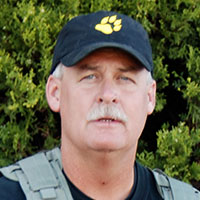
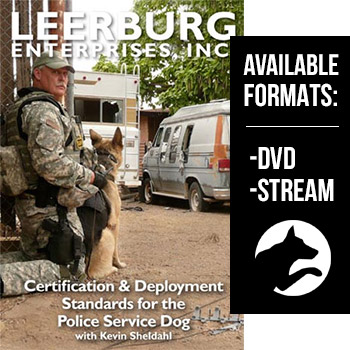
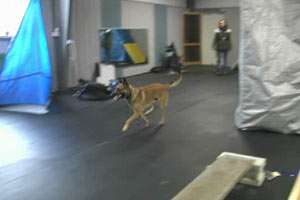
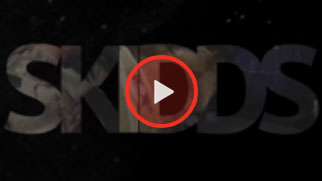
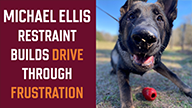
Ask Cindy.